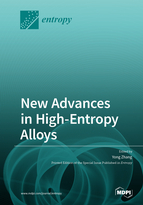New Advances in High-Entropy Alloys
A special issue of Entropy (ISSN 1099-4300).
Deadline for manuscript submissions: closed (28 February 2019) | Viewed by 261600
Special Issue Editor
Interests: high entropy and amorphous alloys; serration and noise in materials; metamaterials
Special Issues, Collections and Topics in MDPI journals
Special Issue Information
Dear Colleagues,
High-entropy alloys (HEAs) are alloys with high-entropy of configuration in the liquid state, this high-entropy intend to make the disordered phases stable, such as random solid solution or amorphous phases. The first generation of HEAs is defined as alloys with more than five components with an equiatomic ratio and single phase, which include face centered cubic (FCC), body centered cubic (BCC), hexagonal close packed (HCP), and amorphous structured HEAs. The recent advances in HEAs mainly focus on the second generation of HEAs, e.g., the non-equiatomic ratio and dual phase HEAs, which include four kinds of HEAs: (1) eutectic HEAs, which have excellent casting properties; (2) precipitation hardening HEAs, which is potentially the next generation of superalloys; (3) phase transformation induced plasticity (TRIP) HEAs; and (4) ultrafine grain HEAs. HEAs potentially break the property limits of the traditional alloys.
This Special Issue specifically emphasizes research that addresses phase formation and alloys design, serration and noise behaviors, large fluctuation and collective phenomena, plastic flow, and flow units. We encourage submissions of the high-entropy films, high-entropy ceramics, etc.
Prof. Dr. Yong ZhangGuest Editor
Manuscript Submission Information
Manuscripts should be submitted online at www.mdpi.com by registering and logging in to this website. Once you are registered, click here to go to the submission form. Manuscripts can be submitted until the deadline. All submissions that pass pre-check are peer-reviewed. Accepted papers will be published continuously in the journal (as soon as accepted) and will be listed together on the special issue website. Research articles, review articles as well as short communications are invited. For planned papers, a title and short abstract (about 100 words) can be sent to the Editorial Office for announcement on this website.
Submitted manuscripts should not have been published previously, nor be under consideration for publication elsewhere (except conference proceedings papers). All manuscripts are thoroughly refereed through a single-blind peer-review process. A guide for authors and other relevant information for submission of manuscripts is available on the Instructions for Authors page. Entropy is an international peer-reviewed open access monthly journal published by MDPI.
Please visit the Instructions for Authors page before submitting a manuscript. The Article Processing Charge (APC) for publication in this open access journal is 2600 CHF (Swiss Francs). Submitted papers should be well formatted and use good English. Authors may use MDPI's English editing service prior to publication or during author revisions.
Keywords
- high-entropy alloys
- alloys design
- plastic deformation
- serrated flow
- high-entropy films
- irradiation
- magnetic properties
- high-throughput







